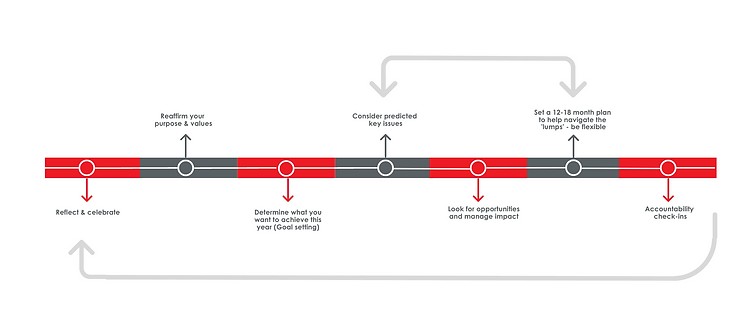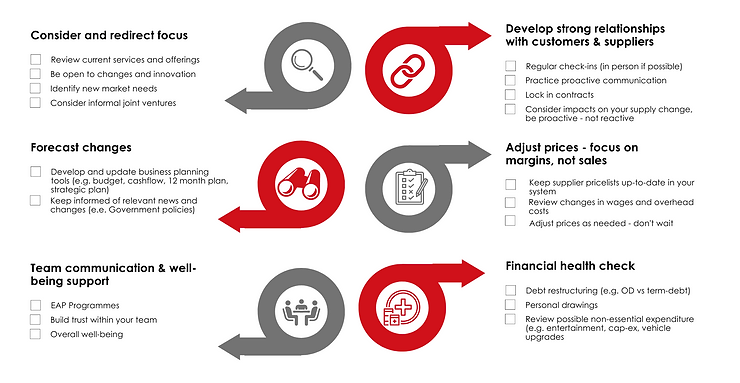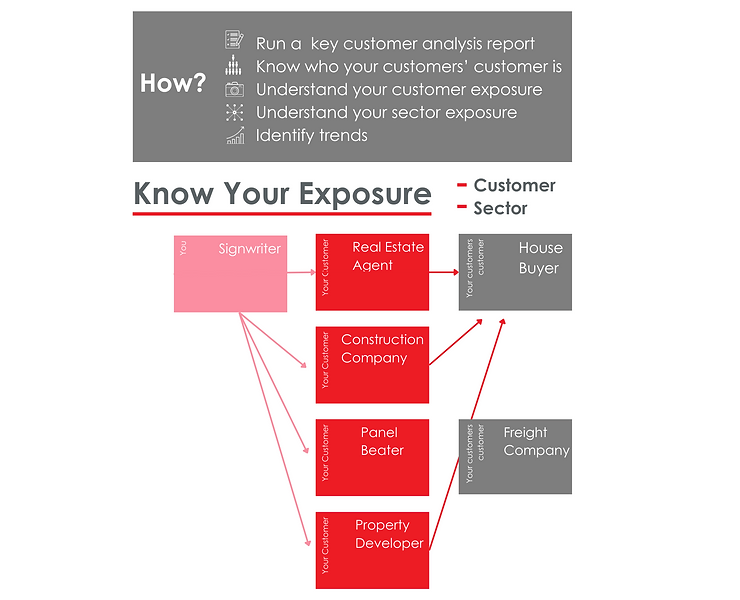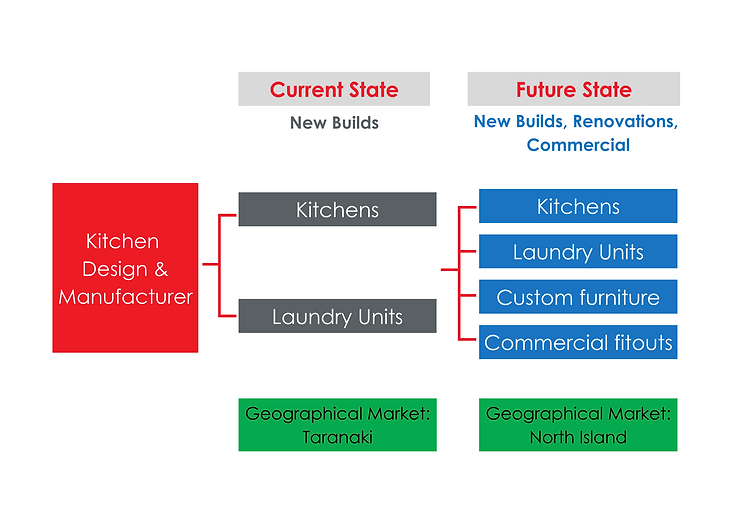Feb
29
How To Prepare Your Business For The Year Ahead
Navigating the business landscape in Aotearoa can be a challenge but fear not! We’re here to guide you through the ins and outs of planning, and how to identify both the risks and opportunities that lie ahead.
In this blog, we break down the planning process, shedding light on the importance of knowing your customers’ customers, and showing you how it all adds up to benefit your business.
The benefits of planning cannot be overstated
Business planning helps you to map out a clear path, set doable goals, spot potential opportunities, and gear up for whatever curveballs may come your way. It lets you make smart decisions early on, keeps stress levels in check, and boosts confidence when facing challenges or grabbing opportunities. Plus, it’s the GPS for your business journey, helping you keep an eye on how well you’re doing and making sure you’re on track to nail those goals. Communication of your business plan is key – keeping the team, customers, and suppliers in the loop is a must.

The planning process
The planning process is an ongoing cycle that starts with reflecting on your past performance, celebrating your successes, and reaffirming your purpose and values.
It involves:
1. determining what you want to achieve in the next year, including what ‘success looks like’ (define this so that you understand how you’re tracking throughout the year).
2. considering key issues that may affect your business in the coming year, such as economic conditions, industry trends, and new legislation.
3. developing a 12–18-month plan outlining how you will achieve your business goals and enabling you to navigate potential challenges or leverage off opportunities.
Be flexible in your approach, you should treat your business plan as a living document and revisit it frequently and have regular accountability check-ins to track progress and make adjustments as needed.
The Planning Process

What might impact your business in 2024?
Anticipated challenges on the horizon for Kiwi business owners in 2024 may encompass:
- Continued inflation and a cooling market
- Employee well-being
- Continued high interest rates
- Attracting and retaining good people
- Government policy and changes due to a new Government
- Large public and private projects are being put on hold .
By identifying the issues that may affect your business in the coming year, early on, you can be on the front foot managing the potential impact. We recommend taking a stance on the ‘mindset’ that your business will implement in the coming year in response to the key issues facing your business, will you be focused on growing your business, holding steady, or declining/downsizing?
Growing your business involves identifying and realising opportunities, such as diversifying your product or service offering, expanding into new markets, or even acquiring a new business.
Holding steady means maintaining the status quo (no major changes) and ensuring your business is stable and sustainable.
Declining or downsizing your business involves reducing your risk and making hard decisions, such as downsizing your team, turning off internal projects, and re-evaluating your product/service mix.

Once you’ve determined the approach you are going to take, ensure that you have developed contingency or different scenario plans for potential changes.
6 areas to consider in your contingency planning:
- Forecast changes and key issues (ideas above)
- Re-directing focus
- Team communication and well-being support
- Customer and supplier relationships
- Adjust pricing to focus on margins, not sales
- Conduct a financial health check regularly to ensure your business remains financially stable and sustainable.
Contingency planning tips

What challenges are you and your customers facing?
Considering the challenges mentioned above (and any others that are relevant to you) in the context of your customers and the industries they ‘play’ in, you can be on the front foot – managing the potential impact and identifying which challenges can be turned into opportunities.
Understanding who your customers are
First you need to understand who your customers are. An easy way to analyse your customers is to pull your customer/sales information from your accounting system. You can then identify what categories make sense to group your customers in (e.g. size, location, industry). We’ll share an example below:
Example One

Looking at the above example of a signwriter who has among their top customers a Real Estate Agent, Construction Company, Panel Beater, and Property Developer; if they have an even spread of revenue coming from each of those customers then they may feel that their key customer exposure risk is at quite a comfortable level.
However, as you can see from looking beyond their immediate customer to the customers’ customers, 3 out of the 4 customers are selling to the same end customer group (House Buyers). This example shows that their customer sector risk exposure is high, given some of the challenges house buyers are facing at the moment, for example, higher interest rates, house prices, government policy, etc.
When you analyse the House Buyer group (your customers’ customers) through the lens of challenges they are currently facing or will likely face in the future, you can quickly identify that group of people is/will be highly impacted and poses a great risk to the future expected sales of the signwriter.
So, while you might have an even spread of income across your top customers, and therefore be feeling quite confident in your customer risk exposure, you may need to consider other ways to group your customers such as by their industry to understand what may be driving their buying behavior. It’s not enough to just think about the challenges you are facing – you need to go beyond that and think about your customers and your customers’ customers. Understand your customer risk exposure levels and think about what challenges are impacting them, and therefore what impact it may have on your business.
Challenging your decision-making
Once you understand who your customers are and what may be impacting their buying behaviors, you then have the opportunity to reassess your decision-making. For example, will you continue to target a particular customer group or industry if you can see there may be a slowdown, or should you focus on an alternative customer group or change your offering to replace lost sales?
Like all things, changing strategies works best if we look ahead, plan, and prepare for the change before the change is forced upon us.
Some challenging questions to ask yourself:
1. Is what I am selling still relevant, desirable, and attainable for my key customers?
2. Can I change who I sell to, what I am selling, or where I am selling it?
3. How hard are my sales going to be hit and which changes will be most effective in reducing the impact?
4. Do I need to implement 1, 2, or all of these changes?
5. What changes do I need to make in my business to shift the focus to the right areas?
In Example Two below, you can see how these challenge questions may change the focus for a kitchen design and manufacturing business.
Example Two

Once you’ve worked out the above, you also need a plan to communicate these changes with existing customers as well as new potential customers – what, where, and how to say it. Getting a clear, effective marketing strategy in place will save you from wasting time and potential revenue.
Understanding who your customers are and what is impacting them enables you to make decisions and changes in your business before your sales are impacted by their changing buying behavior. Knowing your customers well also enables you to take advantage of opportunities, such as new products or services, that are created by changing customer behavior.
Wrap Up
We’ve walked you through the planning cycle, from reflecting on past performance to outlining achievable goals and preparing for potential challenges or opportunities. Flexibility is crucial; treat your business plan as a living document, revisiting it frequently for adjustments.
Anticipating challenges for 2024, we’ve highlighted issues like inflation, employee well-being, high interest rates, and the impact of government policies. It’s not just about identifying challenges; it’s about your mindset. Will you grow, hold steady, or downsize?
Taking it a step further, you need to explore challenges from your customers’ perspective. By understanding your customers’ customers, you gain a deeper insight and can reveal hidden risks. Knowing your customers intimately empowers you to make informed decisions, adapt to changes, and even seize new opportunities. The key is to plan ahead, challenge your assumptions, and communicate effectively.
If you would like our support to formulate your business plan, please get in touch with Velocite.
OR
Download our free business planning toolkit here.